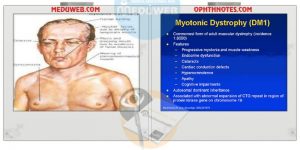Myotonic dystrophy capsule
✍ uncommon
✍ AD dystrophy
✍ triple repeat of MDPK gene
✍ pathognomonic feature is failure of muscle relaxation after contraction.( myotonic ✊ grip ) to check ask patient to shake hands

Ocular manifestation for Myotonic dystrophy :
✍ bilateral ptosis
✍ cataracts (Christmas tree cataracts or PSCC)
✍ orbicularis oculi weakness
✍ pigmentary retinopathy (pattern dystrophy centrally, reticular at mid-periphery, and atrophic far periphery)
✅ Systemic manifestation for Myotonic dystrophy :
✍ mournful facies ( miserably sad)
✍ dysphasia
✍ dysphagia
✍ muscle weakness with delayed relaxation (myotonic grip)
✍ testicular atrophy
✍ frontal baldness
✍ Dropped IQ
✍ cardiomyopathy and conduction abnormalities (may lead to fatal cardiac failure).
✅ Investigations Myotonic dystrophy :
✍ DNA analysis: confirms diagnosis.
✍ ECG: should be performed annually for conduction abnormalities.
✅ Treatment for Myotonic dystrophy :
✍ Multidisciplinary (neurologist , cardiologist , physiotherapist and speech therapist ) .
✍ cataract and ptosis precautious surgery (when symptomatic).
NB ☝☝☝☝☝
✍ General anaesthesia may unmask subclinical respiratory failure.
Myotonic dystrophy powerpoint Presentations:
Myotonic dystrophy BY ; Sandhya Varma 11407042 B.Tech Genetic Engg SRM University.
Myotonic dystrophy (dystrophia myotonica, DM) is a chronic, slowly progressing, highly variable inherited multisystemic disease. It is characterized by wasting of the muscles (muscular dystrophy), cataracts, heart conduction defects, endocrine changes, and myotonia. Myotonic dystrophy can occur in patients of any age. First described by Hans Steinert in 1904, there are now two types recognized (DM1 and DM2). In 1992, a genetic mutation was discovered to cause DM1 – also called myotonic dystrophy of Steinert, or Steinert’s dystrophy. In 1994, a second mutation was found and DM2 was differentiated – also called proximal myotonic myopathy (PROMM). Myotonia means abnormally long muscle contractions or slowed relaxation after a muscle contraction A person with DM often has difficulty relaxing his or her grip, especially in the cold. DM causes general weakness, usually beginning in the muscles of the hands, feet, neck, or face. It may slowly progress to other muscles, including the heart. It also may affect the muscles of the digestive system, causing constipation and other digestive problems DM may affect a wide variety of other organ systems, may adversely affect intellectual abilities, often increases sleep needs & decreases motivation and may have other impacts on personality and behavior. Symptom severity forms the basis for a common classification of DM: 1). “Mild DM” (adult onset): People with “mild DM” often lead active lives and may even be unaware that they have the disorder. 2). “Classical DM” (adult onset): People commonly have muscle weakness and wasting, myotonia, hand and wrist weakness and/or foot drop. 3). “Congenital Myotonic Dystrophy” (CMD): A very severe form of DM1, often fatal in young children (not seen in DM2).


